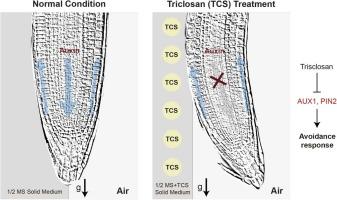植物根系对环境污染物三氯生的回避反应
IF 11.3
1区 环境科学与生态学
Q1 ENGINEERING, ENVIRONMENTAL
引用次数: 0
摘要
三氯生(TCS)是一种常见于个人护理产品和消毒剂中的抗菌剂,因其对人类健康和环境的潜在风险而引起人们的关注。在本研究中,我们观察并研究了拟南芥根系在远离含tcs培养基的情况下定向生长的回避反应。在盐胁迫、脱落酸(ABA)、细胞分裂素和生长素信号通路中受损的突变体的遗传筛选表明,极性生长素运输对于介导tcs诱导的根反应至关重要。值得注意的是,TCS降低了根分生组织中生长素转运蛋白AUX1和PIN2的表达水平。这些发现强调了植物极性生长素转运在TCS响应中指导根生长重新定向的调节作用,使植物能够避免不利的环境条件。破译植物对环境污染物反应的分子机制为制定减少污染物在作物中的吸收和积累的策略提供了有价值的见解,从而加强食品安全和支持人类健康。本文章由计算机程序翻译,如有差异,请以英文原文为准。

The avoidance response in plant root to the environmental pollutant triclosan
Triclosan (TCS), an antimicrobial agent commonly found in personal care products and disinfectants, has raised concerns due to its potential risks for human health and environment. In this study, we observed and investigated an avoidance response in Arabidopsis roots, which exhibited directional growth away from TCS-containing medium. Genetic screening of the mutants impaired in salt stress, abscisic acid (ABA), cytokinin, and auxin signaling pathways revealed that polar auxin transport is essential for mediating this TCS-induced root response. Notably, TCS application downregulated the expression level of auxin transporter proteins AUX1 and PIN2 in the root meristem. These findings highlight the regulatory role of polar auxin transport in directing root growth reorientation in response to TCS, enabling plants to avoid from adverse environmental conditions. Deciphering the molecular mechanisms underlying plant responses to environmental pollutants offers valuable insights for developing strategies to reduce pollutant uptake and accumulation in crops, thereby enhancing food safety and supporting human health.
求助全文
通过发布文献求助,成功后即可免费获取论文全文。
去求助
来源期刊

Journal of Hazardous Materials
工程技术-工程:环境
CiteScore
25.40
自引率
5.90%
发文量
3059
审稿时长
58 days
期刊介绍:
The Journal of Hazardous Materials serves as a global platform for promoting cutting-edge research in the field of Environmental Science and Engineering. Our publication features a wide range of articles, including full-length research papers, review articles, and perspectives, with the aim of enhancing our understanding of the dangers and risks associated with various materials concerning public health and the environment. It is important to note that the term "environmental contaminants" refers specifically to substances that pose hazardous effects through contamination, while excluding those that do not have such impacts on the environment or human health. Moreover, we emphasize the distinction between wastes and hazardous materials in order to provide further clarity on the scope of the journal. We have a keen interest in exploring specific compounds and microbial agents that have adverse effects on the environment.
 求助内容:
求助内容: 应助结果提醒方式:
应助结果提醒方式:


